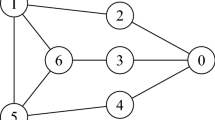Abstract
In this paper we discuss the problem of how to divide the total cost of a round trip along several institutes among the institutes visited. We introduce two types of cooperative games—fixed-route traveling salesman games and traveling salesman games—as a tool to attack this problem. Under very mild conditions we prove that fixed-route traveling salesman games have non-empty cores if the fixed route is a solution of the classical traveling salesman problem. Core elements provide us with fair cost allocations. A traveling salesman game may have an empty core, even if the cost matrix satisfies the triangle inequality. In this paper we introduce a class of matrices defining TS-games with non-empty cores.
Similar content being viewed by others
References
O.N. Bondareva, “Some applications of linear programming methods to the theory of cooperative games,”Problemy Kibernetiki 10 (1963) 119–129. [In Russian.]
D. Granot and G. Huberman, “Minimum cost spanning tree games,”Mathematical Programming 21 (1981) 1–18.
P.C. Fishburn and H.O. Pollak, “Fixed route cost allocation,”American Mathematical Monthly 90 (1983) 366–378.
E.L. Lawler, J.K. Lenstra, A.H.G. Rinnooy Kan and D.B. Shmoys, eds.,The Traveling Salesman Problem: A Guided Tour of Combinatorial Optimization (Wiley, New York, 1985).
W.F. Lucas, “Applications of cooperative games to equitable allocations,” in:Game Theory and its Applications, Proceedings of Symposia in Applied Mathematics, Vol. 24, AMS Short Course (American Mathematical Society, Providence, RI, 1981).
G. Owen, “On the core of linear production games,”Mathematical Programming 9 (1975) 358–379.
G. Owen,Game Theory (Academic Press, New York, 1982).
J.A.M. Potters, “A class of traveling salesman games,” to appear in:Methods of Operations Research.
A. Schrijver,Theory of Linear and Integer Programming (Wiley, New York, 1986) Chapter 19.
L.S. Shapley, “On balanced sets and cores,”Naval Research Logistics Quarterly 14 (1979) 453–460.
L.S. Shapley, “Discussant's comment,” in: S. Moriarty, ed.,Joint Cost Allocation (Oklahoma University Press, Norman, OK, 1981) pp. 131–136.
A. Tamir, “On the core of a traveling salesman cost allocation game,”Operations Research Letters 8 (1988) 31–34.
S.H. Tijs and T.H.S. Driessen, “Game theory and cost allocation problems,”Management Science 32 (1986) 1015–1028.
H.P. Young, “Methods and principles of cost allocation,” in: H.P. Young, ed.,Cost Allocation: Methods, Principles and Applications (North-Holland, New York, 1985) pp. 3–29.
Author information
Authors and Affiliations
Rights and permissions
About this article
Cite this article
Potters, J.A.M., Curiel, I.J. & Tijs, S.H. Traveling salesman games. Mathematical Programming 53, 199–211 (1992). https://doi.org/10.1007/BF01585702
Received:
Revised:
Issue Date:
DOI: https://doi.org/10.1007/BF01585702




